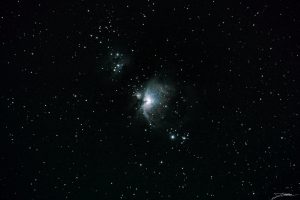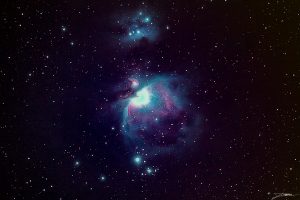SNR, or Signal to Noise Ratio is a concept which comes up regularly in astrophotography (as well as in life, more on that in a bit…). The idea is, you want to capture as much signal as possible, while limiting the amount of noise, so that you can reveal more of ‘what’s actually there’. As I have progressed in this hobby, I have gone through iterations and have developed my abilities in order to address this perpetual issue. Skipping a bunch of the applicable background and math, the noise factor in the SNR can be reduced by a factor equal to the square root of the number of frames (given no other changes). So, to reduce the noise by a factor of 2x, you need to stack 4 frames. 9 frames gets you 3x, 100 frames gets you 10x… and so on.
While this is effective, given a limited amount of imaging time, it’s not always the most efficient way to spend one’s time. Reducing or eliminating noise sources can also help. For example, the following image consists of an average of 197 individual 0.8-second shots:

And this image consists of an average of five 30-second shots:

Yes, the 2nd image is grainier, because there are fewer individual images. However, because I had the camera staring at the same spot in the sky for 30 seconds at a go (vs 0.8), I was capturing nearly 40x the number of photons, while also reducing the noise by dropping from ISO 12,800 to ISO 1,600. So there’s a lot more detail in the Running Man nebula in the 2nd shot. Had I spend another 3.5 minutes and captured another 7 images, I’d have the same amount of integration (the total time the camera is exposed to the stars), but WAY more signal in each individual sub-exposure. Yes, you can get good results by stacking LOTS of sub-exposures. But in the same amount of time, if you can do the things to get more signal AND less noise in each individual sub, you’ll get even better results.
The thing is, the things required to stack lots and lots of fairly noisy exposures: decent lens, decent camera, tripod, decently dark skies; are all pretty easy to do. Here in Vacaville, the sky brightness due to light pollution is much, much less than it was in the DC-area house, meaning I’ve got a big bump in noise reduction right out the gate. And the tripod, lens (this one was borrowed, but I have a ‘decent’ one), and camera are all things I already have. In contrast, the things required to get the 2nd set of subs are significantly more difficult: Precise equatorial alignment, properly calibrated autoguiding, etc.
All of that brings me to the real point of this post: You can spend your time doing lots of reps at low-effort, low SNR activities and get pretty decent averaged-out results for the rest of your life. You do still have to put in some work, but it’s relatively easy, and relatively painless. OR, you can invest some time up front, and develop the skills and strengths to extract more signal and cut out more noise, and get FAR better results out of the same amount of imaging time. Getting the autoguider right was a massive, massive headache. Learning how to get a really good polar alignment (EVERY TIME) was a pain in the ass. But every single imaging session from now on will benefit from what I learned in those frustration-filled failures (read: learning opportunities).
New Year’s resolutions are a funny thing. Lots of people make them. Most people bust them before January is over. But we still keep doing them. Why? Because we know that putting the time in developing some skill or strength will pay dividends down the road. The important thing is to try and cut all the superfluous bullshit that adds noise to our lives. To wit: I’m getting back on my Starting Strength linear progression. I know I haven’t maxed it out yet, which means I have more ‘beginner’ strength gains to make. Yes, I could do more Crossfit, or start rucking, or some other modality… but those are all lower-payoff activities. They’re easier. Now Murph isn’t easy, by any stretch. However, spending an hour doing Murph is easier than spending an hour adding another 5lbs to my squat and deadlift. Heavy deadlifts SUCK. A LOT. But as long as I can keep gaining strength by just adding weight to the bar, I need to keep doing so. Improving astrophotography will require increasing levels of complex skills, because I’ve done a good job at taking care of all the simple stuff. But with weight training, I’ve still got more simple stuff to work on. However in the case of weightlifing, simple ≠ easy, so this is gonna suck. So be it.
“We choose to go to the moon in this decade and do the other things, not because they are easy, but because they are hard, because that goal will serve to organize and measure the best of our energies and skills, because that challenge is one that we are willing to accept, one we are unwilling to postpone, and one which we intend to win, and the others, too.” -JFK, 12 Sep 1962 (emphasis mine)
“Force production is the defining characteristic of your physical existence.” -Mark Rippetoe, October 2017
1 Jan 2018: 1RM – 405lbs
We’ll see where this ends me up at in a year.

Leave a Reply